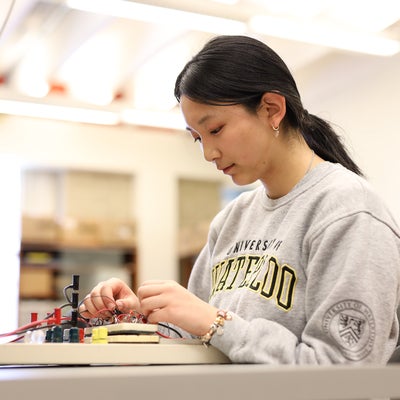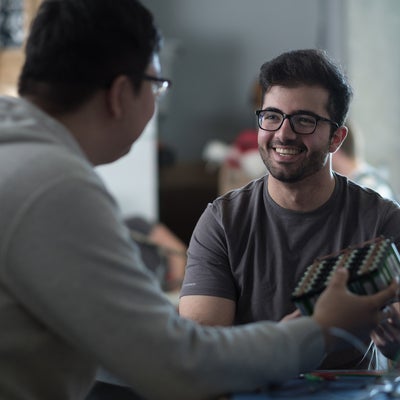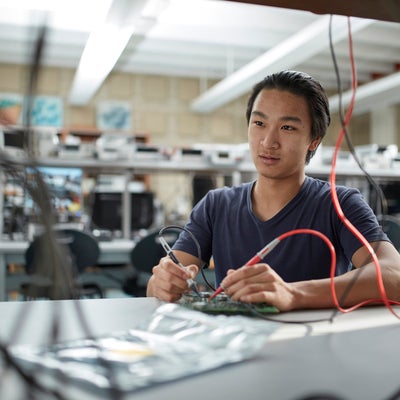Why Electrical Engineering?
Behind just about every advance in information, power and energy, you’ll find an electrical engineer – from developing and optimizing technologies for harnessing renewable energy sources, to developing essential medical equipment.
In this program, you’ll explore electronics, physics and electromagnetism and use them to design a wide range of devices powered by electricity – developing them from concept to reality. You'll specialize in a range of technologies such as power generation and clean energy, electric vehicles, Internet of Things, quantum computing, integrated circuit design and machine learning. When you graduate, you’ll have hundreds of career paths open to you, from designing power stations and aircraft control systems to pioneering the future of microprocessors and telecommunications systems.
Courses in Electrical Engineering
You’ll take a mix of foundational engineering, programming, and mathematics courses in first year. After first year, most of your classes will be Electrical Engineering courses covering topics such as communication systems, electronic circuits, electromagnetic fields and waves, machine learning and AI and analog control systems.
Sample first-year courses
This is a sample schedule. Courses are subject to change.
| 1A Term | 1B Term |
|---|---|
Upper year courses
For information about courses past your first year, check out the Undergraduate Academic Calendar.
Customize your degree with options and specializations
Options
Options are a way to provide you with a path to expand your degree and get a secondary emphasis in another subject or area. Students should decide if they are interested in taking options as they enter second year. Some available options are:
Specializations
A specialization is recognition of selected elective courses within your degree. Specialization offerings are unique to your engineering program and are listed on your diploma. Specializations that are available to Electrical Engineering students include:
Co-op for Electrical Engineering students
You’ll have an unrivalled opportunity to gain paid work experience before you even graduate. We’ll help you navigate job applications, résumés, and interviews; you’ll have the added benefit of trying out different roles and/or industries to find the one that fits you while building your work experience and reinforcing your in-class learning out in the real world. It all adds up to a competitive advantage after graduation.
Starting in first year, you'll normally alternate between school and work every four months, integrating your classroom learning with real-world experience. You can return to the same employer for a couple of work terms to gain greater knowledge and responsibility or work for different employers to get a broad range of experience.
| Year | September to December (Fall) | January to April (Winter) | May to August (Spring) |
|---|---|---|---|
| First | Study | Co-op | Study |
| Second | Co-op | Study | Co-op |
| Third | Study | Co-op | Study |
| Fourth | Study | Co-op | Study |
| Fifth | Co-op | Study | - |
Your first work term will be halfway through first year. Learn more about co-op.
Example co-op positions for Electrical Engineering students
- PCB hardware designer
- Electrical engineering sensor developer
- Hardware design engineer
- Test systems engineering
- Electrical engineer intern
- Junior designer - electrical
- Assistant information analyst
Example careers for Electrical Engineering graduates
- Hardware engineer
- Electrical designer
- Business technology analyst
- Programmer
- Microelectronics engineering
- Application specialist
- Engineering product management
Capstone design projects in Electrical Engineering
Capstone Design is the culmination of the engineering undergraduate student experience, creating a blueprint for innovation in engineering design.
Supported by numerous awards, Capstone Design provides Waterloo Engineering students with the unique opportunity to conceptualize and design a project related to their chosen discipline.
A requirement for completion of their degrees, Capstone Design challenges students teams to push their own boundaries, and apply the knowledge and skills learned in the classroom and on co-op work terms. It reinforces the concepts of teamwork, project management, research and development.
For a full list of previous capstone design projects, see our Capstone Design website.
LightLink (Capstone 2025)
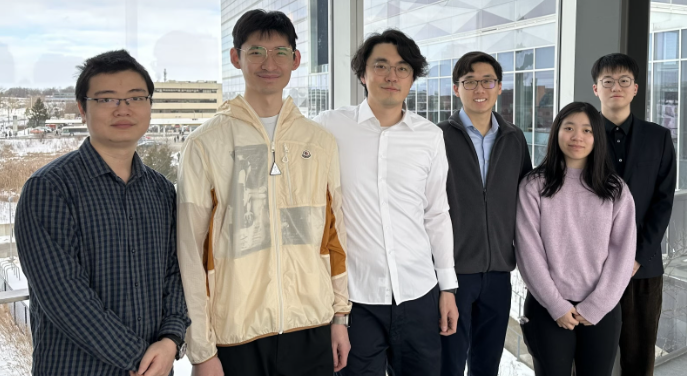
Kevin Chen, Lucy He, Junshi Li, Jason Liu, Yalou Yang, Chenao Yuan
LightLink is a low-cost visible light communication (VLC) technology that integrates into existing lighting infrastructure to provide high-speed data transmission. By leveraging the unlicensed visible spectrum, Lightlink addresses the spectrum limitations of traditional wireless technologies due to the global surge in data traffic. Utilizing advanced signal processing and low-noise circuits using commercial RGB LEDs, photodiodes, and microcontrollers, LightLink establishes visible wavelength channels to improve bandwidth efficiency and reliability, addressing the growing demand for efficient wireless communication.
ScreenTickle
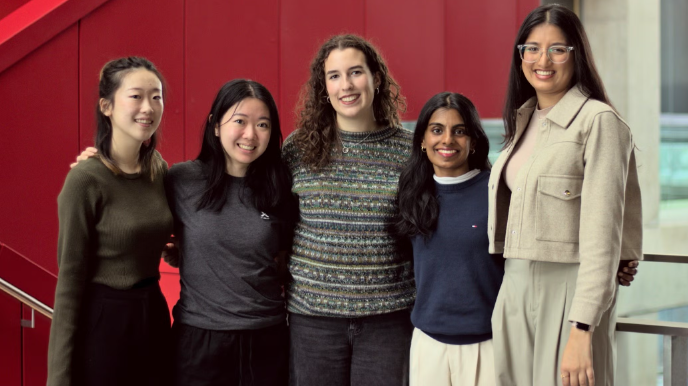
Irene Boby, Wani Gupta, Subin Lee, Ella Smith, Kristin Wu
ScreenTickle is an attachable, touch-enabled frame that transforms non-touch screen devices into touch-responsive devices using infrared (IR) sensors and photodiodes. This frame offers an affordable and seamless upgrade, allowing users to enjoy touch functionality without investing in new hardware. The system detects interruptions in the IR light beams and wirelessly connects to the computer. ScreenTickle is user-friendly, requires no professional installation, and can be easily attached or removed.
Student design teams
The Sedra Student Design Centre consists of over 20,000 square feet of space dedicated to design teams and student projects. There are more than two dozen design teams, all of which are student-led, and many of which represent Waterloo internationally.
Some examples include:
Electrium Mobility

Electrium Mobility is a student design team dedicated to building sustainable, portable, and electric transportation solutions in the form of electric skateboards, bikes, scooters, and other portable electric mobility options.
Waterloo Hacker Fab

Waterloo Hacker Fab is establishing Canada’s first open-source microchip fabrication lab, with all equipment engineered from scratch. Our goal is to develop reliable processes to build NMOSFET chips with a 10-micron gate length in a 24-hour turnaround.
Reality Labs

UW Reality Labs is a student design team at the University of Waterloo that specializes in XR (extended reality) and spatial computing. Our team offers students hands-on experience with cutting-edge VR and AR (augmented reality) technologies, as well as experimental spatial experiences.
Electrical Engineering alumni
Shiva Bhardwaj (BASc '14)

Shiva started a project in his third year called Shocklock which was a mechanical device to save technicians from injuries. At the time, Shiva and his team were able to sell a few thousand devices. After graduation this project evolved into his current company Pitstop.
Read more about Shiva's time in Electrical Engineering.
Barbara Paldus (BASc '93)

Barbara developed a spectrometer a million times more sensitive than existing instruments. Today, cavity ring-down spectroscopy is used for everything from detecting pipeline leaks to ensuring that every banana in a shipment ripens at the same time.
Read more about Barbara earning the alumni achievement medal.
Dhananja Jayalath (BASc '12)

Dhananja developed an idea for a product that could enhance people’s fitness training by telling them which parts of their bodies needed attention. Fast-forward eight years and his wearable technology company, Athos, has received 42 patents for its innovations.
Read more about Dhananja winning a young alumni achievement medal.
Sefunmi Osinaike (BASc '17)

Sefunmi came to Waterloo from Nigeria with a clear goal: to join the Enterprise Co-op program and gain real-world tech experience. Today, as co-founder of Co.Lab, he’s helped over 1,000 learners in 50+ countries launch tech careers at top companies like Apple, Google, and Amazon—and earned a spot on Forbes’ 30 Under 30 list.
Read more about Sefunmi's journey in entrepreneurship.

